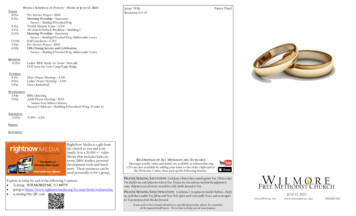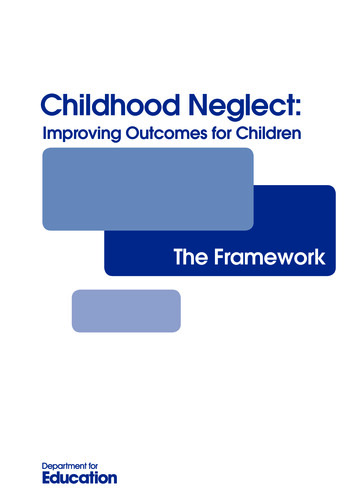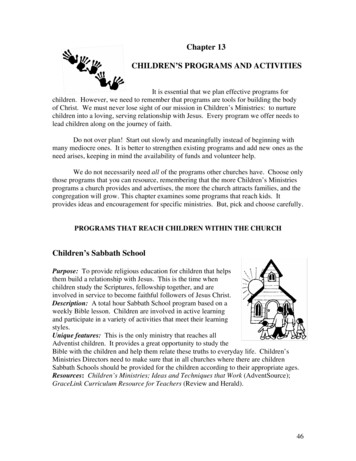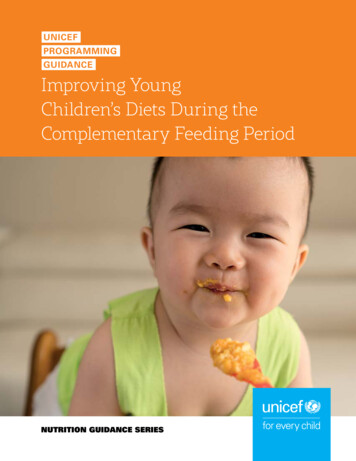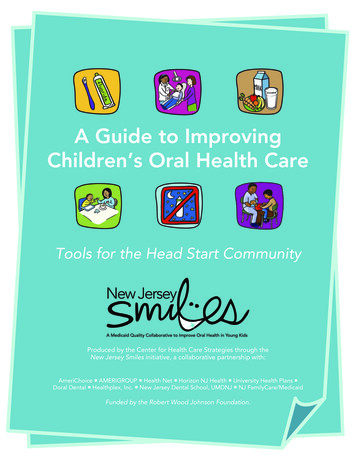
Transcription
A Guide to ImprovingChildren’s Oral Health CareTools for the Head Start CommunityProduced by the Center for Health Care Strategies through theNew Jersey Smiles initiative, a collaborative partnership with:AmeriChoice AMERIGROUP Health Net Horizon NJ Health University Health Plans Doral Dental Healthplex, Inc. New Jersey Dental School, UMDNJ NJ FamilyCare/MedicaidFunded by the Robert Wood Johnson Foundation.
A Guide to Improving Children’s Oral Health Care: Tools for the Head Start CommunityAcknowledgementsAuthorsSheree Neese-Todd, MACenter for Health Care StrategiesBonnie Stanley, DDSBureau of Dental Services,Division of Medical Assistance andHealth Services,New Jersey Department of HumanServicesLauren Marino, MPH*Center for Health Care StrategiesEditorWe thank the participating organizations for contributing to New JerseySmiles, and to a number of individuals for their invaluable guidance on thedevelopment of this toolkit. From the New Jersey Head Start community,we extend special appreciation to Suzanne Burnette, Velda Font-Morris,Claudette Martindale, Heather Martindale and Shawanna Stradford; fromthe New Jersey Department of Human Services, Division of MedicalAssistance and Health Services, we thank Clifford Green, DMD; from theUCLA School of Dentistry, we thank James J. Crall, DDS, ScD, clinicalconsultant to New Jersey Smiles, and from the Center for Health CareStrategies, we thank Nikki Highsmith, Kamala Allen, and RosaNovatkowski. Thank you to the Caring for Colorado Foundation forproviding many of the graphics included this toolkit. New Jersey Smilesexpresses deep appreciation to the Robert Wood Johnson Foundationfor the support to make the collaborative and this toolkit possible.Stacey Chazin, MPH, CHESCenter for Health Care StrategiesDesignerMichael CanonicoCenter for Health Care StrategiesAbout New Jersey SmilesThe Center for Health Care Strategies launched New Jersey Smiles: AMedicaid Quality Collaborative to Improve Oral Health in Young Kids toimprove the dental care of young children in New Jersey. This initiativecomprises the state's five Medicaid managed care health plans, NJFamilyCare/Medicaid, New Jersey Head Start, and other regional partnerswho are committed to improving access to oral health services for youngchildren. New Jersey Smiles, an 18-month effort funded by the RobertWood Johnson Foundation, is working closely with Early Head Start/HeadStart (EHS/HS) staff to establish dental homes for children at risk for poororal health.About the Center for Health Care StrategiesThe Center for Health Care Strategies (CHCS) is a nonprofit health policyresource center dedicated to improving health care quality for low-incomechildren and adults, people with chronic illnesses and disabilities, frailelders, and racially and ethnically diverse populations experiencingdisparities in care. CHCS works with state and federal agencies and healthplans to develop innovative programs that better serve Medicaidbeneficiaries. For more information, visit www.chcs.org.* Lauren Marino contributed to this toolkit as an intern for the Center for Health Care Strategies. She is currently a senior financial analyst in the Managed Caredepartment at New York Presbyterian Hospital System.-1-
A Guide to Improving Children’s Oral Health Care: Tools for the Head Start CommunityTable of ContentsForeword . 3Using this Toolkit . 4I. Overview of Oral Health in EHS/HS Children . 5Tooth Decay in Young Children . 5Low Rates of Dental Care in High-Risk Children . 5EPSDT Requirements for Young Children . 5II. Establishing Dental Homes for EHS/HS Children . 6Your Role in Children’s Oral Health. 6What is a Dental Home? . 6Connecting Children to a Dental Home . 7III. Strategies for Engaging Families in Oral Health Care . 12Helping Families Overcome Barriers to Better Oral Health Practices . 12Family Role Playing . 13Family Workshops . 14Handouts for Families . 14IV. Activities for the EHS/HS Classroom . 15Prevention . 15Checking Mouths and Teeth . 16Educational Activities. 16Dental Safety. 16Appendix A: Resources for Ensuring Dental Homes . 17Periodicity of Dental Services for Children in NJ FamilyCare/Medicaid . 17Confirming NJ FamilyCare/Medicaid and HMO Enrollment . 18HMO Contact Information . 22NJ FamilyCare/Medicaid “Using Your Benefits” Fact Sheet . 23NJ FamilyCare/Medicaid Enrollment Form . 24Sample Consent to Release Health Records Form . 26Dental Visit Tracking Form . 27Appendix B: Resources for Family Education . 28A Healthy Mouth for Your Baby . 28Self-Management Goals . 29Images of Serious Tooth Decay in Children . 30Keeping Your Teeth Healthy: Information for Pregnant Women and New Mothers . 31Taking Care of Baby’s Teeth: Information for Parents and Caregivers of Infants . 32Taking Care of Children’s Teeth: Information for Parents and Caregivers of Young Children. 33Information on Dental Safety for All Children . 34Appendix C: Resources for the Classroom . 35Toothbrush Storage . 35Oral Safety Tips for EHS/HS Sites and Family Homes . 36What to Do in a Dental Emergency . 37Songs to Sing with Children to Promote Oral Health . 38Glossary of Oral Health Terms . 39-2-
A Guide to Improving Children’s Oral Health Care: Tools for the Head Start CommunityForewordDental caries (tooth decay) is the most common chronic disease of young children, disproportionatelyaffecting those from low-income families. Fifty percent of all preschoolers suffer from tooth decay by age 5;and rates exceeding 60% have been recorded among children in some Head Start programs. Unfortunately,tooth decay in preschoolers often goes untreated, despite federal Medicaid/EPSDT guidelines that recognize1the benefits of early oral health care and provide coverage for comprehensive dental services.Head Start and Early Head Start program directors, training and technical assistance providers, andAdministration for Children and Families officials have reported that poor access to oral health services,particularly treatment services, continues to be the number one health issue impacting Head Start and EarlyHead Start children. In response, efforts such as the American Academy of Pediatric Dentistry (AAPD) HeadStart Dental Home Initiative and New Jersey Smiles are addressing and making impressive strides towardimproving dental care access for Head Start children.A Guide to Improving Children’s Oral Health Care: Tools for the Head Start Community was produced by NewJersey Smiles to support the role of Medicaid as a critical partner in improving dental care for this population.As the health insurer for most high-risk, low-income children — including those enrolled in Head Start andEarly Head Start — NJ Medicaid and its contracted managed care organizations (MCOs) are integral toimproving access to comprehensive dental care, including diagnostic, preventive and treatment servicesbeginning in early childhood.This guide provides strategies and supporting resources for New Jersey Head Start programs to work withMedicaid, MCOs, community dental providers, families and children to improve oral health care andestablish dental homes for young children. It also serves as a useful model for Head Start programs in otherstates where Medicaid MCOs serve this high-need, under-served population.I commend New Jersey Smiles for this achievement and for being among a group of forward-thinkingorganizations undertaking innovative, collaborative approaches to oral health care for young children.James J. Crall, DDS, ScDDirector, AAPD Head Start Dental Home InitiativeConsultant to New Jersey Smiles1Schneider, Rossetti, and Crall, National Oral Health Policy Center, Assuring Comprehensive Dental Services in Medicaid and Head StartPrograms: Planning and Implementation considerations. October 2007.-- 33 --
A Guide to Improving Children’s Oral Health Care: Tools for the Head Start CommunityUsing this ToolkitA Guide to Improving Children’s Oral Health Care: Tools for the Head Start Community was written to help Early HeadStart/Head Start (EHS/HS) staff work with NJ Family Care/Medicaid, health maintenance organizations (HMOs),and community dental providers to ensure continuous and comprehensive dental care for New Jersey’s low-incomechildren.Local EHS/HS staff played a large role in creating this toolkit. As a result, it contains practical information tocoordinate and promote oral health care for EHS/HS children in a format that is easy to use. Included are resourcesto support EHS/HS children’s use of dental exams and treatment, and their practice of healthy dental habits athome and in the classroom.The toolkit is arranged as follows:Section I:Provides an overview of oral health problems in young children, and discusses low rates of dentalcare in high-risk children such as those in NJ FamilyCare/Medicaid.Section II:Explains the meaning of a “dental home,” and offers guidelines and resources to help EHS/HS staffenroll children in NJ FamilyCare/Medicaid and establish dental homes for them.Section III: Suggests ways that EHS/HS staff can educate families about the importance of oral health, and helpthem to overcome barriers to prevention, evaluation, and treatment.Section IV: Offers ways to include prevention, examination, and oral health education, along with dental safety,in the EHS/HS classroom to teach children healthy habits. Included are step-by-step instructions fororganizing on-site limited dental exams.Please look for the Action Step symbol throughout the toolkit foreasy-to-follow tips.-4-
A Guide to Improving Children’s Oral Health Care: Tools for the Head Start CommunityI. Overview of Oral Health in EHS/HS ChildrenTooth Decay in Young ChildrenDental caries — or tooth decay — is the most common chronic disease in children. Affecting about half of U.S.children by age 9, it wears away tooth enamel and causes dental caries. In infants, toddlers and preschool-agechildren, it is called early childhood caries (ECC) or baby bottle caries. Dental caries is contagious, and often passesfrom mother to child through contact with saliva.2Children attending EHS/HS are at higher risk of dental caries than others. These conditions can lead to: Pain, infection, and decaying teeth and gums; Being teased by peers for their appearance; Problems with school attendance and performance; and Delayed overall development in young children with severe cases.Minority and low-income children have the highest rates of dental caries, with severe cases seen in 25% of thehighest-risk, low-income group. Children in households below 200% of the federal poverty level — about half ofchildren in the U.S. — have three-and-a-half times more tooth decay than those in wealthier families.Unfortunately, the majority of children in NJ FamilyCare/Medicaid are at a higher risk of dental caries and poororal health.34Low Rates of Dental Care in High-Risk ChildrenWhile dental caries can be prevented and treated, dental care is the most common unmet treatment need inchildren. Consider: In 2007, only 22% of all eligible NJ FamilyCare/Medicaid children ages 1-5 received any dental service,and only 20% received preventive dental care. Low-income children, in particular, often only access dental care when they have a problem, such as painor swelling from decayed teeth. Close to 80% of decayed teeth in preschool-age children who live in households below 100% of the federalpoverty level go untreated.5678EPSDT Requirements for Young ChildrenGiven its important role in reducing barriers to dental care for many EHS/HS children, NJ Family/CareMedicaid published the New Jersey Dental Periodicity Table (see Appendix A). With recommended dentalservices for children at specific ages, the table follows Medicaid Early & Periodic Screening, Diagnosis, andTreatment (EPSDT) requirements and American Academy of Pediatric Dentistry recommendations. It is auseful resource for community dentists, EHS/HS workers, families and caregivers. Highlights include: Children should see the dentist for the first time at the eruption of their first tooth, but no later thanage 1. After their first dental visit, children should see their dentist at least twice a year for preventiveservices. Once treatment needs are identified by the dentist, necessary follow-up care must be provided.2U.S. Department of Health and Human Services, Administration for Children and Families. Guide to Children’s Dental Care in Medicaid(October 2004).3Ibid.4Ibid.5Ibid.6Division of Medical Assistance and Health Services, State of New Jersey. CMS-416: Annual EPSDT Participation Report (March 2008).7U.S. Department of Health and Human Services, op cit.8National Oral Health Policy Center (October 2007). Assuring comprehensive dental services in Medicaid and Head Start programs:planning and implementation considerations.-5-
A Guide to Improving Children’s Oral Health Care: Tools for the Head Start CommunityII. Establishing Dental Homes for EHS/HS ChildrenYour Role in Children’s Oral HealthWithin 90 days of a child’s entry into the EHS/HS program, the local EHS/HS site is required to: Determine if the child has an ongoing source of continuous, accessible dental care;Help the family to find a dental home if they do not have one;Record the results of dental visits; andMake sure the child has a dental plan that includes return visits and follow-up treatment.What is a Dental Home?A dental home is a source of continuous, comprehensive, and compassionate oral health care delivered or directedby a licensed dentist. It is the one practice a family goes to over time for all their dental health needs.A dental home should be: Familiar with a child’s health history and have a relationship with him or her; Able to benefit children at highest risk for oral health disease through early intervention and a full rangeof oral health services; Easy to get to in a child’s community; and Family-centered – reminding families when they are due for visits, working with them when appointmentsare broken, and helping them to establish preventive oral health “home care.”Action Step: Determine if a Child Has a Dental HomeAsk families the following questions: Does your family have a dentist? If yes, does the dentist treat all of your children, including the child enrolled in EHS/HS? When was the last time your child went to the dentist? Was this for an exam or aproblem? How many times in the last year has your child seen the dentist? When is the next time you plan to take your child to the dentist?-6-
A Guide to Improving Children’s Oral Health Care: Tools for the Head Start CommunityConnecting Children to a Dental HomeNJ FamilyCare/Medicaid, the HMOs that serve Medicaid families, and community dental providers are threeresources for linking eligible EHS/ HS children to dental homes.1. NJ FamilyCare/MedicaidNJ FamilyCare/Medicaid is a health insurance program that helps New Jersey's low-income children and certainparents and guardians to have affordable health coverage (see Appendix A). It serves most EHS/HS families.Benefits – NJ FamilyCare/Medicaid is committed to helping its child beneficiaries get comprehensivedental care. Once a family is enrolled, NJ FamilyCare/Medicaid will provide them with a Health BenefitsIdentification (HBID) card, and link them to one of six participating HMOs. The HMOs offer thefollowing dental benefits to most children: Preventive dental care;Dental evaluation and diagnostic services; andComprehensive and emergency dental treatment.Enrollment – While many EHS/HS children are eligible for NJ FamilyCare/Medicaid, some eligiblefamilies do not enroll because they are unaware of or do not understand the program.Action Step: Help Families Enroll in NJ FamilyCare/Medicaid During the EHS/HS intake process, ask families if they have insurance. If they areenrolled in NJ FamilyCare/Medicaid, ask to see their HBID card to confirm (seeAppendix A). If a family is uninsured, explain the NJ FamilyCare/Medicaid program and provideenrollment materials (see Appendix A). Note that benefits may take up to three monthsto go into effect. Tell the family that NJ FamilyCare/Medicaid will not pay for any dentalcare that is provided before benefits are in place. If families choose not to apply for NJ FamilyCare/Medicaid, try to find out why andattempt to remove any barriers. Follow up with families to see if they have submitted an application and are enrolled. If a child is not enrolled within 90 days of entering EHS/HS, try to get free dentaltreatment for the child through a local community health center or social service agencythat provides dental care to uninsured children. For additional information, contact NJ FamilyCare/Medicaid at 1-800-701-0710,Monday – Friday, 8 a.m. to 5 p.m.; Mondays and Thursdays until 8 p.m. Applications inEnglish and Spanish are available online at: www.njfamilycare.org.-7-
A Guide to Improving Children’s Oral Health Care: Tools for the Head Start Community2. Health Maintenance OrganizationsOnce families are enrolled in NJ Family Care/Medicaid, they must join one of the six participating HMOs: AmeriChoiceAMERIGROUPHealthfirst NJHorizon NJ HealthThe HMOs can help to find dental homes for EHS/HS children by: Linking families to local dentists who are accessible and available to see young children; Giving EHS/HS staff the names of providers to contact directly; and Coordinating the dental care children receive.Action Step: Explain to Families the Benefits Offered by HMOsAll of the HMOs offer: Access to general dentists and pediatric specialists through member self-referral; Coverage for diagnostic and preventive services, including limited and comprehensiveexams, fluoride treatment, and dental sealants; For the majority of children, coverage for comprehensive treatment such as fillings,cleanings, and extractions; and Emergency dental treatment for pain within 48 hours (sooner for a more seriouscondition), and urgent care appointments within three days of request.Action Step: Determine a Child’s HMO MembershipIf a family is already enrolled in an HMO, determine which one that is. To find this out: Ask the family to look at their HMO membership card, or ask to see the card yourself. If a family does not have a card, show them pictures of each HMO’s card to help themidentify their plan (see Appendix A). Ask your grantee to look up this information in the NJ FamilyCare/Medicaid eligibilitydatabase; this requires a consent form signed by the parent/guardian (see Appendix A).Guidelines for explaining this form are included in Appendix A. If the above steps are not successful, help the family contact the Medical AssistanceCustomer Center Hotline, which will provide information about participating HMOs, at1-800-356-1561.-8-
A Guide to Improving Children’s Oral Health Care: Tools for the Head Start CommunityAction Step: Work with HMOs to Link Each Child to a Dental HomeHMOs and EHS/HS staff should work together in the following ways:HMO ActivityEHS/HS Staff Support ActivityProvide multilingual andculturally sensitive familyeducation materials (viamail, web, and/ortelephone). Help families find dentalproviders and makeappointments. In special cases, arrangetransportation. Set up “work around”plans with families to helpthem keep appointments. Connect families with culturally competent EHS/HS staff.Meet with families to review materials and to offer positivereinforcement.Talk to families about visiting the dentist and keeping scheduledappointments.Help families contact their HMO to find a local provider.Confirm if appointments have been made.Determine if transportation problems will affect visiting the dentist.Give families community transportation contact information and/orhelp them to schedule a ride.Contact HMO for support in hardship cases (e.g., children withspecial needs).As a last resort, determine if EHS/HS can provide transportation, andarrange for it.Ask families why they missed appointments, and set up plans to workaround the issues.Work with families and HMOs to avoid broken appointments.Follow up with families to confirm if appointments are rescheduledand provide appointment reminders.-9-
A Guide to Improving Children’s Oral Health Care: Tools for the Head Start Community3. Community Dental PartnersEHS/HS staff should contact local dental providers identified by the HMOs to see if they are willing to providedental homes for EHS/HS children. Building relationships with these providers can help keep them committed tomeeting the children’s dental needs.Action Step: Meet with Local DentistsTo have effective meetings with local dentists, EHS/HS staff should: Review the site’s oral health plan, including EHS/HS intake procedures, and determinewhich local providers (participating in the Medicaid HMOs) to approach. Invite both the dentists and their office managers to the meeting, and be available tomeet after dental office hours. Bring lunch to the dental office or meet at a nearby restaurant. Explain the EHS/HS program, and how the site will help them serve the children. Ask for an overview of the practice, including how many patients can be seen each day,and which HMOs serve the practice. Offer to provide transportation for office visits, a translator, name tags, consent forms,and a brief medical history for children as needed. Tell them about the American Academy of Pediatric Dentists’ (AAPD) NJ Head StartDental Home Initiative, which will be training teams of dentists and EHS/HS staff inoptimal oral health practices, and providing parents, caregivers and EHS/HS staff withinformation and resources to support oral health.A good EHS/HS dental provider has: A child-friendly office with a clean, inviting waiting room, and chairs and equipment sized for children; Staff who are child-friendly and multilingual; Willingness to schedule group appointments for exams; Availability of evening and weekend hours; Policies that allow exams without a parent present (but with parental consent); and Willingness to visit the EHS/HS site to provide limited exams and/or fluoride varnish.- 10 -
A Guide to Improving Children’s Oral Health Care: Tools for the Head Start CommunityAction Step: Organize On-Site Limited Dental ExamsLimited dental exams at EHS/HS sites do not replace a comprehensive exam at a dental office,and do not meet the requirement of a dental home. Instead, they serve to identify children’sdental needs and refer them to a dentist for regular care.Following are steps to organizing limited dental exams at the EHS/HS site:1. Contact providers who perform on-site limited exams far in advance of the desired examdate.Use the NJ Smiles Provider Directory to find a nearby dentist who will perform limiteddental exams at your site. If one cannot be found, ask HMO representatives to help identifydentists in your community who see young children.Schedule a time to talk to the dentist (face-to-face or over the phone) to discuss: Number of children to be examined, and transportation needed for any office visits;Whether the dentist will bring other staff and/or require EHS/HS staff assistance;Whether the exams will be done in groups and, if so, the group size;Whether the dentist will provide preventive services, such as fluoride treatments ordental sealants;Date(s) for the exam visit;How each child’s HMO will be identified;Parental outreach and education prior to the visit;Forms required by the provider, and whether those are needed in advance;Referral process for follow-up treatment; andTracking of procedures performed, for the parents and EHS/HS records.2. Have parents complete consent forms for on-site limited exams (see Appendix A forexample).Consent, or “Authorization for Release of Information,” forms should include: Types and any cost of services that will be provided; Name of family’s HMO; Parent’s daytime contact information; and A note that parents will be contacted if the child needs additional treatment.3. Ensure that a follow-up dental care plan is in place for each child after the on-site exam,and help the family to follow through on that plan. The dentist will provide the exam results and an overview of treatment needed. Give each parent the names of available dentists and HMO contact information (seeAppendix A), so an appointment can be made. Work with families and HMOs to ensure the child sees a dentist for an exam. As required, track the results of children’s limited dental exams and future visits (seeAppendix A).- 11 -
A Guide to Improving Children’s Oral Health Care: Tools for the Head Start CommunityIII. Strategies for Engaging Families in Oral Health CareProviding education, support, and assistance directly to EHS/HS families can help improve children’s oral healthand use of dental care. EHS/HS staff can do this in a number of ways.Helping Families Overcome Barriers to Better Oral Health PracticesBelow are some challenges EHS/HS staff may face when encouraging healthy family dental practices, and ways tohelp get past them:ChallengeFinancial: Family is unsure if they canafford dental services and/ortransportation to appointments.Possible Solutions for EHS/HS Staff Time: Multiple jobs, other siblings,and/or ailing relatives prevent familyfrom visiting the dentist. Language: English is not family’s firstlanguage, which prevents them fromaccessing oral health education andservices. Cultural: A family’s cultural backgroundaffects oral health attitudes andbehaviors. Tell family that NJ FamilyCare/Medicaid benefits are usuallyfree.Remind parents to reenroll annually.If family is not eligible, reach out to local community-basedclinics and FQHCs to provide a dental home.Inquire if EHS/HS has funds for dental treatments.Assist with transportation needs by contacting social servicesagencies. If they cannot meet the family’s need, contact theirHMO.Help family schedule a babysitter or find a clinic that seeschildren on weekends and evenings.Secure treatment consent from parents, allowing EHS/HS staffto take child to dentist.Connect family with EHS/HS staff member who cancommunicate in family’s primary language.Refer family to their health plan’s multilingual services.Use multilingual materials included with this toolkit (seeAppendix B) and at EHS/HS.Establish EHS/HS “cultural champions” — staff members fromfamilies’ racial and ethnic groups — who can communicateeffectively with parents.Show
Low Rates of Dental Care in High-Risk Children While dental caries can be prevented and treated, dental care is the most common unmet treatment need in children. 5 Consider: In 2007, only 22% of all eligible NJ FamilyCare/Medicaid children ages 1-5 received any dental service, and only 20% received preventive dental care. 6
